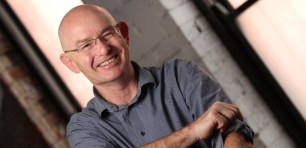
Winely co-founders, CEO Jacob Manning and chief technology officer Abbe Hyde. Source: The Lead
As vintage gets underway in South Australia, wine-tech company Winely has joined the South Australian Landing Pad program to set up shop in the wine state.
Founded in 2017, the company develops sensors placed inside wine tanks that provide real-time fermentation analysis to winemakers via cloud-based software.
Winely currently has three South Australian wineries using its technology, along with several in New Zealand and America.
Winely co-founder and CEO Jacob Manning said most of the company’s manufacturing will still occur outside of Australia due to volume restrictions with local manufacturers.
Instead, the company will focus more on research and development of their products with Australian winemakers and researchers, who Manning referred to as the “world leaders” in wine.
“If we go into an obscure [South Australian] wine region, we’ll generally know the people we’re working with by name, so that’s really exciting,” Manning said.
“The amount of academic talent in terms of technical winemakers, makes South Australia a great place for research and development.”
Winely has been awarded $80,000 under its landing pad agreement, with $40,000 to be used towards office space and $40,000 to hire local professional services suppliers.
Manning said the funding was just the “cream on top” of the deal.
“The thing is, if you put the cash on the side, it’s still awesome to be able to work with the South Australian team, because if you’re entering a new market, it takes quite a bit of time, and you’re not sure who to speak with.”
Winely’s operating model is based on a hardware and Software-as-a-Service platform, with wineries paying an annual subscription to lease the sensor hardware and gain access to the cloud-based software.
Manning said by providing winemakers with constant access to fermentation information, winemakers can move from a “reactive state” to a “planning state”.
“The reason why it’s better is generally a winery only gets two samples a day,” Manning explained.
“They take a sample of a ferment in the morning, and a sample at night…you only get a snapshot of what’s happening in a ferment.
“And often because that piece of information is delayed, a winemaker may take up to 72 hours in getting that info and making a decision. In terms of a ferment, 72 hours is a long, long time, and a lot can go wrong in that time.
“We do real-time sampling, so you get a sample every second on the ferment, and you can make accurate decisions and we also prompt with warnings [over SMS or email] if something is going outside of spec.”
As health and safety restrictions tighten in the wine industry, Manning said automatic technology such as Winely’s sensors will become “a necessity and some stage”.
As Winely continues to develop its technology, Manning said the company was looking forward to helping winemakers move towards smart wineries.
This article was first published by The Lead South Australia.
Handpicked for you

Scrappy, nimble and just a little bit structured: How Airwallex is managing hypergrowth in the midst of a pandemic



COMMENTS
SmartCompany is committed to hosting lively discussions. Help us keep the conversation useful, interesting and welcoming. We aim to publish comments quickly in the interest of promoting robust conversation, but we’re a small team and we deploy filters to protect against legal risk. Occasionally your comment may be held up while it is being reviewed, but we’re working as fast as we can to keep the conversation rolling.
The SmartCompany comment section is members-only content. Please subscribe to leave a comment.
The SmartCompany comment section is members-only content. Please login to leave a comment.